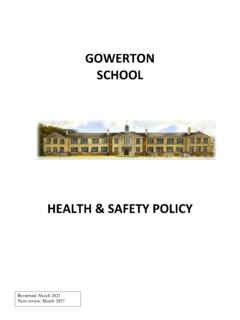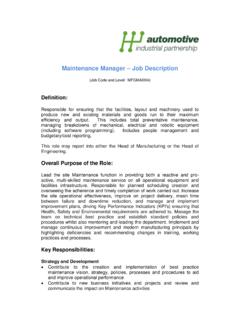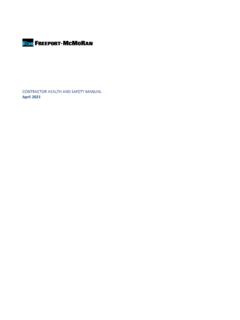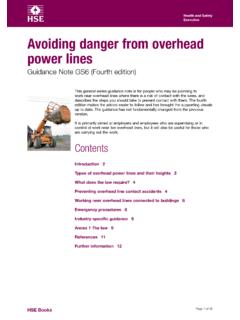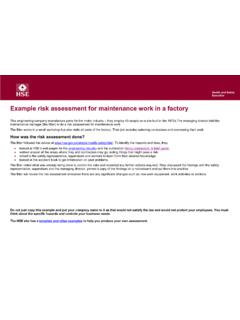Transcription of HEALTH, SAFETY and ENVIRONMENT POLICY - MOORE
1 health , SAFETY and ENVIRONMENT . POLICY . 1. Introduction MOORE Business Systems (PNG) Limited, referred to hereafter as MOORE , is committed to providing and maintaining a safe and healthy workplace for all staff, reducing any impact our operation might have on the ENVIRONMENT , and to providing the information, training and supervision to all staff and contractors needed to achieve this. MOORE will take responsibility for health , SAFETY & ENVIRONMENT procedures, however employees need to be aware of their responsibilities and comply with the company health , SAFETY & ENVIRONMENT policies and procedures. Each employee is encouraged to play a vital and responsible role in maintaining a safe and healthy workplace and caring for our ENVIRONMENT through: Being involved in the workplace health , SAFETY & ENVIRONMENT system.
2 Sticking to correct procedures and equipment use. Wearing protective clothing and equipment as and when required. Reporting any pain or discomfort as soon as possible. Ensuring all accidents and incidents are reported immediately. Helping new employees, trainees and visitors to the workplace understand the right procedures and why they exist. Telling your manager immediately of any health , SAFETY or environmental concerns. Keeping the work place tidy to minimise the risk of any accidents or mishaps. Your participation is much appreciated. 2. health , SAFETY & ENVIRONMENT POLICY statement 1. This POLICY will say how MOORE will manage its health , SAFETY &. environmental responsibilities. 2. MOORE will manage health , SAFETY & ENVIRONMENT POLICY by: Controlling the health and SAFETY risks at work.
3 Involving employees on health , SAFETY & ENVIRONMENT issues that affect them. Making sure that where employees work, and any equipment they use, is safe. Making sure dangerous substances are stored, used and disposed of in a safe and environmentally friendly manner. Making sure employees, especially new employees, have relevant information and training on health , SAFETY & ENVIRONMENT POLICY . Making sure employees can do their jobs, and are properly trained. Trying to stop accidents and work-related health problems. Regularly checking that working conditions are safe and healthy. Regularly reviewing this POLICY and making changes if necessary. 3. Authorised by: David S Doig April 7, 2010. General manager & Director 3.
4 Responsibility for health , SAFETY & ENVIRONMENT 4. Overall responsibility for the management and administration of this POLICY is given to the General manager . 5. Daily responsibility for managing this POLICY is given to National Operations manager . 6. The following people have responsibilities for: Who: Responsibility: National Operations manager 1) Emergency Evacuation Human Resource Administrator 2) H&S induction National Operations manager 3) H&S risk assessment Human Resource Administrator 4) Employee representative National Operations manager 5) First Aiders Operations manager - MDI. Human Resource Administrator Production manager National Operations manager 6) Accident / incident recording, investigating and reporting General manager & Director 7) Environmental impact National Operations manager reduction and POLICY setting.
5 7. Employees are responsible for: Co-operating with the above people who are responsible for health , SAFETY & ENVIRONMENT POLICY and procedures. Using SAFETY equipment as and when it is necessary. Taking care of their own health and SAFETY . Reporting health and SAFETY concerns to the right person as written in this POLICY . Taking care when disposing of dangerous goods, chemicals. Ensuring that all recycling programs are maintained. 4. Controlling the health , SAFETY & ENVIRONMENT risks in the workplace 8. The National Operations manager will do regular health and SAFETY risk assessments. 9. The results of the risk assessment will be given to the General manager and will be included with this POLICY . 10.
6 The General manager should agree any action needed to manage the risks that have been found. 11. The National Operations manager will carry out the agreed action points. 12. The National Operations manager will check that the actions taken have reduced the risks. 13. Assessments will be carried out every 12 months or when there is a change to a work area or process, or incident. 5. Risk Assessment Guidelines A risk assessment is a careful examination of what in a work area or process could cause harm to people, risk to health , ENVIRONMENT or equipment damage. The aim is to make sure that no one gets hurt or becomes ill, and the risk of damage to the ENVIRONMENT , equipment or property is minimised with an incident free target of zero.
7 Step One Identify the hazards First walk around the workplace identifying anything that could be potentially hazardous - write everything down - make a list. Include everything you can think of: not just things that are currently obviously dangerous, but anything with a potential risk. Where possible two people will undertake the risk assessment separately and will compare lists afterwards, in case either has missed anything out. Consider invisible hazards chemical fumes, stress (often related to working long hours, under pressure, to tight deadlines) or physical assault. Finally consider whether things that might not normally be hazardous, might be in relation to specific people pregnant women, asthma sufferers, disabled workers, etc.
8 Step Two identify who is at risk Once you have identified and listed all the hazards, you need to (i) identify what the specific risk is, and (ii) who is particularly at risk. Some people will be more at risk from particular hazards than others - for example a computer user will be more at risk of suffering RSI (Repetitive Strain Injury - also known as WRULDs - Work Related Upper Limb Disorders), a cleaner might have specific risks related to the chemical cleaning agents being used, etc., and there will be those particularly at risk in some circumstances for example because they may be working alone, or they may have a disability. List those potentially at risk. Step Three Evaluate the risks and decide on precautions Think about what you can do to remove the risk.
9 Compare what you currently do with what is accepted as good practice. (It may be necessary to seek advice from experts). The main purpose of doing a risk assessment is to be aware of the risks, so that you can take action to eliminate or at least reduce the risks. if an electrical wire is exposed, you could replace it, or cover it with insulating tape. if your cleaner is using potentially dangerous chemical agents - change the cleaning product - use something water-based. Write down the actions currently taken and those actions you propose to be taken, and write down who will take the action, by when. 6. Step Four Record your findings Ensure a written record of your findings is made available to staff, and that they co-operate with the carrying out of the recommendations made as a result of the assessment.
10 Step Five Review your assessment. You must review your assessment when there are major changes in the workplace, such as the introduction of new machinery, or new ways of working - but you must carry out regular reviews anyway . at least annually. If your original assessment was properly recorded the review should be a relatively simple job but be aware of changing working practices. Involving employees 14. The employee health , SAFETY and ENVIRONMENT representative is the HR. Adminstrator. 15. A group of employees of no less than 5 full time employees will form part of the HSE working group and will meet on no less than two occasions annually to review and discuss any HSE issues or concerns. 16. HSE working group concerns and recommendations will be reviewed by the Executive Management and any decisions made at Management meetings concerning health , SAFETY and ENVIRONMENT will always be recorded and made available to staff.
